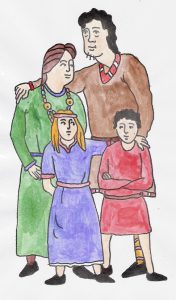
The father was the head of the family in Anglo-Saxon England, and the spear propped up by the door symbolised his role as protector. In fact, the father’s side of the family was called the ‘sperehealf’, while the mother’s side was called the ‘spinelhealf’. The spindle summed up her role in the family, and possessions found in men’s and women’s graves confirm this.
It may have been that the father was expected to be quite strict, and even a little distant from his children. The mother’s brother (‘eam’) may have been a more caring and friendly male relative, though he only visited from time to time.
Old English has many more words for different family relatives than modern English, which shows how important the idea of ‘family’ was for them. If you weren’t very good at remembering all the complexities, though, you could call any relative ‘brōðor’ or ‘sweostor’.
You might have ‘stēop-‘ relatives, if your own parents were dead, or ‘fōster-‘ parents, if your real parents had given you away for some reason.
There were almost certainly four or five people in the average family – records from the year 1200 suggest 4.68*. Other relatives, then as now, of course, may have ‘lived in’.
People outside the family, but whose name, family and origin were known would count as ‘cýðð’. Everybody in the village and the surrounding area would count in this group. Together, your family and friends were ‘cýðð and cynn’, or ‘kith and kin’ in Modern English.
People you didn’t know could become ‘cýðð’ or a ‘frēond’ or guest after they’d explained exactly who they were. Otherwise, strangers were seen as little different from enemies or slaves – ‘ðēow’.
*quoted in ‘Domesday Quest’, Michael Wood, BBC books, 1986
Thanks also to AC Haynes, ‘Anglo-Saxon Kinship’, in ‘Wiðowinde’, Winter 1998
